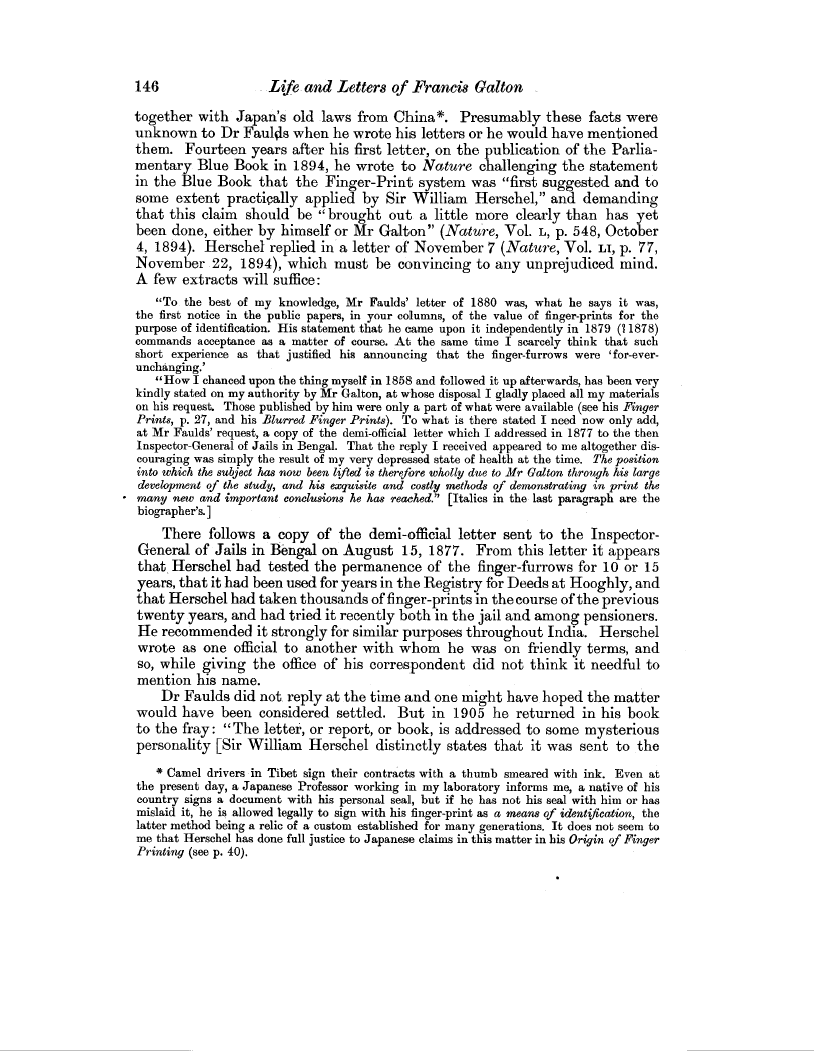| ||||||

OCR Rendition - approximate
146 Life and Letters of Francis Galton together with Japan's old laws from China*. Presumably these facts were unknown to Dr Faulds when he wrote his letters or he would have mentioned them. Fourteen years after his first letter, on the publication of the Parliamentary Blue Book in 1894, he wrote to Nature challenging the statement in the Blue Book that the Finger-Print system was "first suggested and to some extent practically applied by Sir William Herschel," and demanding that this claim should be "brought out a little more clearly than has yet been done, either by himself or Mr Galton" (Nature, Vol. L, p. 548, October 4, 1894). Herschel replied in a letter of November 7 (Nature, Vol. LI, p. 77, November 22, 1894), which must be convincing to any unprejudiced mind. A few extracts will suffice "To the best of my knowledge, Mr Faulds' letter of 1880 was, what he says it was, the first notice in the public papers, in your columns, of the value of finger-prints for the purpose of identification. His statement that he came upon it independently in 1879 (l 1878) commands acceptance as a matter of course. At the same time I scarcely think that such short experience as that justified his announcing that the finger-furrows were 'for-everunchanging.' "How I chanced upon the thing myself in 1858 and followed it up afterwards, has been very kindly stated on my authority by Mr Galton, at whose disposal I gladly placed all my materials on his request. Those published by him were only a part of what were available (see his Finger Prints, p. 27, and his Blurred Finger Prints). To what is there stated I need now only add, at Mr Faulds' request, a copy of the demi-official letter which I addressed in 1877 to the then Inspector-General of Jails in Bengal. That the reply I received appeared to me altogether discouraging was simply the result of my very depressed state of health at the time. The position into which the subject has now been lifted is therefore wholly due to Mr Galton through his large development of the study, and his exquisite and costly methods of demonstrating in print the many new and important conclusions he has reached." [Italics in the last paragraph are the biographer's.] There follows a copy of the demi-official letter sent to the InspectorGeneral of Jails in Bengal on August 15, 1877. From this letter it appears that. Herschel bad tested the permanence of the finger-furrows for 10 or 15 years, that it had been used for years in the Registry for Deeds at Hooghly, and that Herschel had taken thousands of finger-prints in the course of the previous twenty years, and had tried it recently both in the jail and among pensioners. He recommended it strongly for similar purposes throughout India. Herschel wrote as one official to another with whom he was on friendly terms, and so, while giving the office of his correspondent did not think it needful to mention his name. Dr Faulds did not. reply at the time and one might have hoped the matter would have been considered settled. But in 1905 he returned in his book to the fray: "The letter, or report, or book, is addressed to some mysterious personality [Sir William Herschel distinctly states that it was sent to the * Camel drivers in Tibet sign their contracts with a thumb smeared with ink. Even at the present day, a Japanese Professor working in my laboratory informs me, a native of his country signs a document with his personal seal, but if he has not his seal with him or has mislaid it, he is allowed legally to sign with his finger-print as a means of identification, the latter method being a relic of a custom established for many generations. It does not seem to me that Herschel has done full justice to Japanese claims in this matter in his Origin of Finger Printing (see p. 40).
|